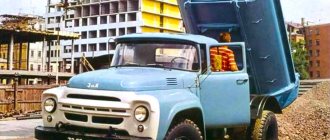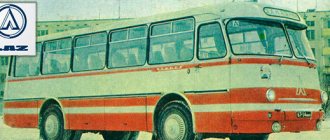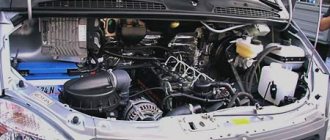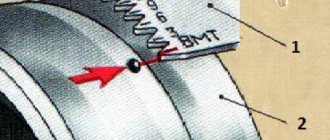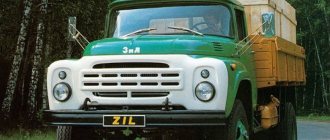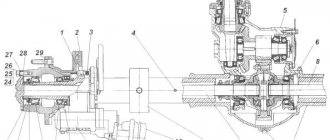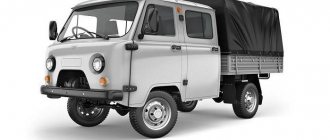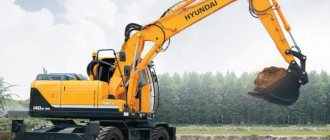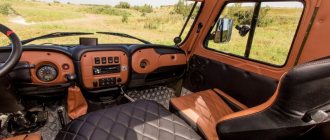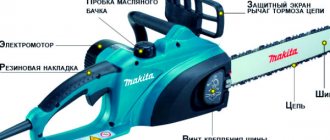The active development of the Russian industry for the mass production of cars for various purposes began during the years of the USSR. Some models turned out to be outright failures, but those production models also appeared that were later deservedly called true legends of the domestic automotive industry. One of them certainly includes the ZIL-130 truck.
History of the creation of ZIL-130
The predecessor of the ZIL-130 is considered to be the ZIL-164, which was essentially just a slightly modernized copy of the far from flawless ZIS-150 truck.
A fundamentally new truck was developed under the leadership of chief designer A. M. Krieger and engineer G. A. Fest. And E.V. Sabo and the chief artist of the plant T.P. Kiseleva worked on the external appearance.
There is an opinion that the appearance of the car was copied from one of the Ford models. And it cannot be argued that no borrowing actually took place.
Externally, the 130 really strongly resembles trucks such as the International R series, Dodge C series and Ford F series. However, we are definitely not talking about 100% plagiarism. Factory specialists simply followed fashion trends of the time. Even now, many modern cars can sometimes be distinguished from each other only by their logo.
A test sample of the new truck was released in 1956. The process of running-in and improvements lasted for several more years. They decided to install a water-cooled V-shaped eight-cylinder engine designed for mass production, easy to manufacture, but quite technologically advanced and reliable on the car.
Start of serial production
The machine was launched into production in 1964 at the Likhachev plant. There, the process of modernization, aimed specifically at mass production of cars, had just completed. Just 10 years later, the millionth truck rolled off the factory assembly line. And by 1994, when the decision was made to discontinue production of this model, there were already almost 4 million cars produced.
The vehicle's carrying capacity was about 5.5 tons, but the robust design of the frame and rear axle made it possible to overload the vehicle without much damage to performance characteristics. The maximum speed when unloaded was 90 km/h. True, gasoline consumption reached almost 40 liters per hundred kilometers. But in the 60s and 70s in the USSR they did not pay attention to fuel economy.
The truck could start from 2nd and even 3rd gear. First gear was used mainly on steep climbs and when driving along rugged terrain.
One of the distinctive features of the ZIL-130 was its signature color. The vast majority of trucks of that time were produced with the ability to quickly transfer the civilian cargo fleet to the needs of the armed forces. And therefore their color was predominantly green. The cabin of this car was sky blue with a snow-white front part.
There are many theories as to why it was painted in these particular colors. The most common opinion is that there is a banal excess of blue paint in the USSR, as well as the comparative cheapness of its production.
The modernized ZIL-131 was produced especially for army needs.
AMUR
CJSC "Automobiles and Motors of the Urals" (AMUR), Novouralsk, Sverdlovsk region, st. Avtomotornaya, 1
In 2003, the assets of the Ural Automotive Plant (a subsidiary of AMO ZIL) were acquired by the financial and industrial concern Severnaya Kazna from Yekaterinburg, changing its name (AMUR). Currently, the main products of the enterprise are AMUR brand vehicles and special equipment for municipal services, the oil and gas industry, the Armed Forces and the Ministry of Emergency Situations. In 2005, about 1,100 cars rolled off the production line of the enterprise.
One of the promising projects is organizing the assembly of commercial trucks of the Indian company Tata Motors. In 2004, the partners signed a contract for the licensed production of the Tata LPT 613 truck, which received the designation AMUR-4346 in the Ural Automobiles and Motors model range. Refinement of the vehicle made it possible to completely adapt its design to Russian operating conditions. The process of localization of production has been organized: currently, when assembling Indian cars, approximately 10% of components are produced in Novouralsk. In the future it is expected to increase this result by 40%. The only exceptions are engines and gearboxes, which will come from India.
The AMUR-4346 model with a cab over the engine uses: in-line six-cylinder turbodiesel Tata 697TS55 with a displacement of 5675 cm3 and a power of 130 hp. With. (Euro-2), 5-speed manual transmission, ZF rack and pinion steering with hydraulic booster, service drum brakes with dual-circuit drive, dependent suspension on longitudinal springs, radial tires size 7.50R-16. The carrying capacity of the chassis is 3,800 kg, and that of the on-board vehicle is 3,500 kg. The optional configuration includes a pre-heater and a power take-off. On the basis of this model, specialized factories produce tow trucks and vans of various types, install hydraulic manipulators and other technical equipment.
According to the contract, which was signed in 2006, the Urals, together with Tata, must produce 1,200 AMUR-4346 trucks. In 2007, AMUR plans to begin assembling another truck model of the Indian corporation. In total, by 2010 it is planned to produce 7 thousand cars of various models.
The production of vehicles of the AMUR-5313 (6x6) and AMUR-53131 (4x2) families, which are based on the design of the well-known ZIL-131 and ZIL-130 trucks, respectively, continues. Outdated, but at the same time reliable and easy to use, and, moreover, affordable, these cars are still in demand. The mentioned models can be equipped with cabs and tail surfaces from the ZIL-131 or modern and more comfortable models borrowed from the ZIL-4331 truck. AMUR-5313 onboard vehicles with a lifting capacity of 3750 kg are equipped with various types of engines. Among them is the AMUR-456.10 (ZIL-508.10) gasoline engine with a power of 150 hp. s., an alternative to which are diesel engines from the Minsk Motor Plant: 108-horsepower D-245.12 and 136-horsepower D-245.9E2 (Euro-2). Upon request, our own V-shaped 8-cylinder units can also be installed: AMUR-0555 with a displacement of 7.6 liters and a power of 145 hp. With. and AMUR-5551 (6.28 l and 180 hp). All samples use a manual 5-speed gearbox and a 2-speed transfer case. Vehicles of the AMUR-53131 series with a payload of 6 tons are equipped with AMUR-456.10, AMUR-0550 and D-245.12 engines. In 2006, the modification AMUR-53131M became the owner of a 136-horsepower diesel engine D-245.9E2. The engines are coupled with a 5-speed manual transmission. The listed models serve as a suitable transport base for the installation of various special equipment: tank trucks, concrete mixer trucks, fire fighting equipment, various types of municipal vehicles, dump trucks, hydraulic lifts.
The AMUR-5312 (4x2) and AMUR53123 (6x6) cars are a symbiosis of chassis (frame, axles, suspension, etc.) manufactured in Novouralsk with cabs supplied by the Minsk Automobile Plant. The cabover layout made it possible to increase the useful length of the cargo compartment by almost a meter. Two-axle models are equipped with a short cab, AMUR-5551 and D-245.9 engines, and a 5-speed ZIL-5301 manual transmission.
The latest version of AMUR-531202 is equipped with an in-line 4-cylinder Volvo Penta TAD420VE turbodiesel with a displacement of 4.04 liters and a power of 140 hp, installed together with a Volvo KB115 clutch and a 5-speed ZF manual gearbox. A chassis with a load capacity of 6690 kg and a 6-ton flatbed truck are offered.
The all-wheel drive version of AMUR-53123, produced in the chassis and on-board version with a load capacity of 8 tons, includes an extended cab with a berth, a 200-horsepower diesel engine AMUR-555 or its Minsk competitor MMZ-260.11 and a 2-speed transfer case. In the first case, the SAAZ-433420 5-speed manual transmission was used on the all-terrain vehicle, in the second - its Yaroslavl analogue YaMZ-236P. The following options are available: tire pressure regulation system, pre-heater, power take-off, cable winch. It is possible that with the technical assistance of MAZ, the cabins will be manufactured directly in Novouralsk.
The AMUR-531211 two-axle all-wheel drive vehicle with a carrying capacity of 4 tons, which is designed for transporting people and goods on all types of roads, also finds its customers. This model, equipped with the same engines and transmission units (gearbox, transfer case, drive axles), has a Kama Automobile Plant cabin located above the engine. The use of lighter engines (to reduce the load on the front axle) gives AMUR an advantage in cross-country ability over similar models produced by KamAZ. For an additional fee, a winch and a tire pressure regulation system are installed.
In 2006, Novourals presented the AMUR-531210 (4x2) two-axle truck. Its main difference from its predecessors is the use of a cabover cab produced by the Chinese FAW plant (which once belonged to the Mitsubishi Fighter model). A sleeping place is provided for the driver. The role of the power plant in the 6-ton car is performed by the D-245.9 diesel engine. Negotiations are underway with a Chinese manufacturer to assemble various types of trucks at AMUR.
Another aspect of AMUR CJSC’s activities is cooperation with Daewoo Trucks, owned by Tata Motors. We are talking about establishing the assembly of heavy-duty vehicles in Novoyralsk. It is possible that their production will begin as early as 2007. It is expected that the annual production volume will be 1–2 thousand trucks, the main consumers of which will be construction and transport enterprises. Subsequently, due to the localization of production of components such as frames and cabins, the price of these vehicles will decrease by 10–15%.
Motor
The longitudinal engine arrangement, traditional for the 60s, required the cars to have large elongated hoods. The use of a V-twin engine made it possible not to lengthen the front part of the truck too much.
The six-liter engine produced about 150 hp. With. Nowadays one would expect at least 300 horsepower from an engine of this volume. But structurally such power was not required then. In addition, the engine ran on A72, A76 gasoline, and high compression would create detonation.
In the 70s, when the issue of too much fuel consumption began to be raised, they decided to install a diesel engine on some cars, the development of which took a long and painful time.
In 1974, engineers prepared the first prototype of the ZIL-645 engine. Its displacement was 7.6 liters and its power was 160 hp. and 451 Nm of torque. The first tests showed that the traction and dynamic characteristics of the motor are not enough to work as part of a road train with a total weight of 20.5 tons.
It took another two years to finalize the unit. As a result, in 1976, a modernized ZIL-645 engine appeared with an increased displacement to 8.74 liters and a power of 185 hp. and a torque of 510 Nm. True, not all cars were equipped with it anyway. Most of the new ones continued to be produced with the same gasoline engine.
Since 1991, production of the ZIL-431410 and ZIL-431412 chassis models began in the city of Novouralsk, Sverdlovsk Region, at an automobile engine plant that had previously assembled engines and military trucks ZIL-157 and ZIL-131. The unique appearance of the ZIL-431410, produced in Novouralsk, was given by the tail and front part of the ZIL-131, which outwardly turned the car into a kind of hybrid of the 130th and 131st ZILs.
On September 5, 2003, the plant’s assets were purchased by the Yekaterinburg financial and industrial group “Northern Treasury - Industry” (“SK-prom”), which registered the Automobiles and Motors of the Urals CJSC (AMUR).
Since 2004, the company began producing cars of the AMUR-5313 (6x6) and AMUR-53131 (4x2) families with the AMUR-456.10 (aka ZIL-508.10) engine without any “ZIL” markings. The machines are based on the design of the ZIL-131NA (ZIL-131N with unshielded electrical equipment) and the ZIL-431410, respectively. The mentioned models could be equipped with cabs and tails from the ZIL-131N or modern and more comfortable models borrowed from the ZIL-4331 truck.
Outdated, but incredibly durable and reliable, simple and unpretentious to operate, and, moreover, affordable, the six-ton truck continued to be in demand.
At the Novouralsk enterprise, in addition to the standard 150-horsepower gasoline engine ZIL-508.10 (aka AMUR-456.10), a number of other power units were installed on the ZIL-431410 (aka AMUR-53131). In particular, the 108-horsepower diesel engine D-245.12 from the Minsk Motor Plant; V-shaped 8-cylinder power units AMUR-0555 (7.6 l) and AMUR-5551 (6.28 l) of our own design, with a power of 145 and 180 hp, respectively. In 2006, the AMUR-53131M modification was equipped with a 136-horsepower D-245.9E2 diesel engine with turbocharging and intercooling of air, meeting Euro 2 environmental standards. The engines were coupled with a 5-speed manual transmission.
Continuing to produce the archaic ZIL-130 and ZIL-131 trucks, the plant spent a year unsuccessfully trying to make them more modern. First, a cabin from MAZ was adapted to the unfortunate ZIL. Then - from the Chinese FAW truck. There was even an example with a Volvo engine! And at the 2008 Motor Show, the “one hundred thirty” and “one hundred and thirty first” arrived with new fiberglass cabins.
As long as there was demand, its production continued. In 2005, about 1,100 vehicles rolled off the production line of the enterprise, including about 800 AMUR-53131 vehicles. In 2008, the plant sold only 411 cars, in 2009 - 191. The last one-piece units were apparently manufactured in 2010.
Advantages and disadvantages
ZIL-130 was distinguished by its simplicity, unpretentiousness and low cost of maintenance. At the same time, the presence of telescopic hydraulic shock absorbers on the front axle created quite comfortable conditions for being in the cabin, which could easily accommodate three people.
The five-speed transmission was also quite good. As a result of various modifications, the truck tractor could easily pull semi-trailers with a load of 12 tons.
The disadvantages of the model included:
1. High fuel consumption.
2. Almost complete lack of passive safety.
On today's secondary market, ZIL-130 trucks in working condition or in need of restoration can cost from 50 to 300 thousand rubles. Various exclusive variations are more valuable.
Truck "Amur-53131" - a modification of the famous ZIL-130
Return of "one hundred and thirty"
S. Iones
It is generally accepted that production of the legendary ZIL-130 truck has long been discontinued. Indeed, ZIL discontinued it back in 1994. True, the ZIL-4333, the successor to the “one hundred and thirty” with a new cabin, remains in the production program of the Moscow plant.
At one of the recent exhibitions, our attention was attracted by the brand new airborne ZIL-130, as if returning from the times of developed socialism. Even the blue color is the same one that most of these cars were once painted in. There is nothing unusual in the wings and cladding taken from the ZIL-131: “one hundred and thirty” with “one hundred and thirty-first” tail have been around for decades.
This car was not made by ZIL. In Soviet times, in the city of Novouralsk, Sverdlovsk region, there was a “secret” automobile plant, a branch of ZIL, where they produced military off-road trucks - first ZIL-157, then ZIL-131. In the 1990s, the plant mastered the production of the ZIL-130, and its wings and lining were unified with the “main” three-axle model. Thus, the Ural modification of the ZIL-130 became similar to the hybrids that were built at car depots and repair plants since the late 1960s. But in the capital region, such vehicles were not sold for a long time: trucks from the ZIL assembly line dominated here.
Today AMO ZIL and the Ural UAMZ are not just different enterprises, they have become competitors. But one Moscow company selling freight transport offered the consumer a truck of the Amur-53131 brand, a modification of the famous ZIL-130 produced in Novouralsk.
The cabin interior is designed for retro lovers: unlined doors, antique dashboard, seats and windshield wipers; windshield, divided in half, from ZIL-131. Apart from the cockpit, much remains the same: the familiar “one hundred and thirtieth” airborne platform, old lighting fixtures. There is not even an underrun buffer at the rear; instead there is a bracket with a spare wheel.
The place of the uneconomical and non-compliant 8-cylinder carburetor engine was taken by a 4-cylinder Minsk diesel engine. “Amur-53131” is equipped with a modification of the engine with the index MMZ-245.9, which complies with Euro 2 standards. It differs from the diesel engine used on most “Bychkov” by turbocharging and an air intermediate cooling system (intercooler). Power is 136 hp. The installation of such a motor entailed a small change in the cabin. Under the instrument panel there is a block of indicator lights taken from the “Bull” panel.
But there is nothing new in the power unit. ZIL produces cars of the 4333 family with Minsk diesel engines, and “Bulls” equipped with turbocharged engines of the “ninth” series are also available. Back in the 1990s, some owners independently installed diesel engines of the same family, taken from the MTZ tractor, on ZILs.
In addition to the flatbed truck, the Ural plant offers chassis for specialized vehicles. Garbage trucks and irrigation tanks based on the Amur-5313 have already appeared. The Mytishchi plant has mastered a construction dump truck with a body from the 1980s model - ZIL-MMZ-4505. Now he has an index of 3518.
The scale of production of Amura-53131 is small: about 800 trucks were manufactured last year. But now in the Moscow region they sell at least 100 cars a month. At the Ural plant, of course, they are working on a new cabover model; they are trying to install a cabin from MAZ or the Chinese FAW on the former Zilov chassis with a Minsk diesel engine. For a number of reasons, such cars still remain one-off units, and the good old ZIL-130 under the pseudonym “Amur” is “more alive than all living things.” Many consumers in our country are quite satisfied with a time-tested truck assembled from familiar components.
In conclusion, let's reveal a little secret. We intend to have such a machine at our disposal in the near future and conduct comprehensive tests of it, the results of which, of course, will be published on the pages of GP.
